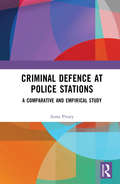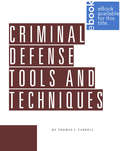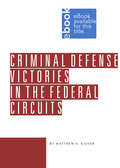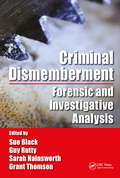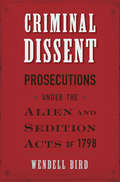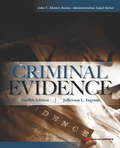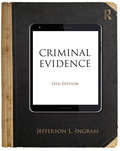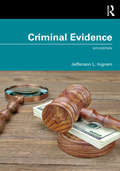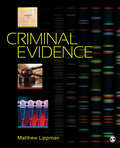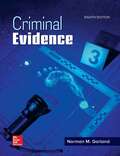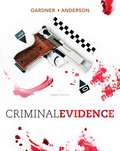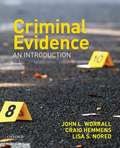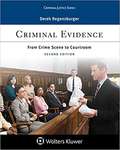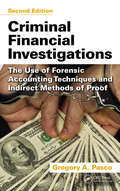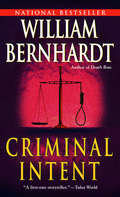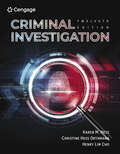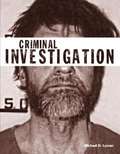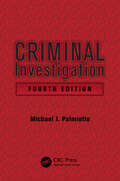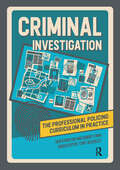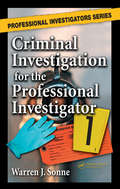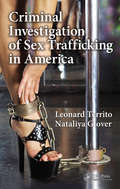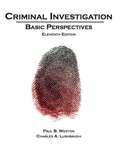- Table View
- List View
Criminal Defence at Police Stations: A Comparative and Empirical Study
by Anna PivatyCriminal defence at the investigative stage has attracted growing attention due to the shifting focus of the criminal process onto pre-trial stages, and the recent European regulations adopted in this area. Increasingly, justice practitioners and legislators across the EU have begun to realise that ‘the trial takes place at the police station’. This book provides a comprehensive legal, empirical and contextual analysis of criminal defence at the investigative stage from a comparative perspective. It is a socio-legal study of criminal defence practice, which draws upon original empirical material from England and Wales and the Netherlands. Based on extensive interviews with lawyers, and extended periods of observation, the book contrasts the encountered reality of criminal defence with the model role of a lawyer at the investigative stage derived from European norms. It places the practice of criminal defence within the broader context of procedural traditions, contemporary criminal justice policies and lawyers’ occupational cultures. Criminal Defence at Police Stations questions the determinative role of procedural traditions in shaping criminal defence practice at the investigative stage. The book will be of interest for criminal law and justice practitioners, as well as for academics focusing on criminal justice, criminology, socio-legal studies, legal psychology and human rights.
Criminal Defense Tools and Techniques
by Thomas J. FarrellImprove your advocacy, speed trial preparation, avoid pitfalls, and be ready for surprises with Thomas J. Farrell's Criminal Defense Tools and Techniques. This book is loaded with proven angles of attack that will improve your effectiveness in all stages of your representation ... from initial interview through sentencing. Mr. Farrell supports his strategies with pattern argument language, model questions, 130 forms, real-life examples, checklists, and 1,400 case citations. Here is a small slice of what he covers: * identifying weaknesses in the prosecution's case * extracting concessions in pretrial motions and hearings * cross-examining government experts * defending specific crimes * mitigating the offense at sentencing * and much more For proven arguments, hundreds of forms, and effective tactics for criminal cases, purchase the latest edition of Criminal Defense Tools and Techniques by Thomas J. Farrell.
Criminal Defense Victories in the Federal Circuits
by Matthew G. KaiserCriminal Defense Victories in the Federal Circuits is not your average, run-of-the-mill case digest. This collection of almost 200 case summaries, culled from all 11 Circuits and the D.C. Circuit, is as entertaining as it is informative. Author Matthew G. Kaiser explains the law and the rationale underlying the courts' decisions in a narrative style that is smart, thoughtful, witty, and highly readable. Criminal Defense Victories in the Federal Circuits: * Covers a broad range of topics, from Evidence & Trials to Federal Sentencing to Searches & Seizures and Tax Offenses. * Demonstrates the many ways a federal criminal defendant can win: The indictment may be dismissed; the case may be remanded for a new trial or resentencing; a conviction may be reversed. A victory may be based on substantive or procedural grounds; judicial error; juror misconduct; or prosecutorial overreaching. * Gives detailed attention to the facts of each case, as well as the court's legal analysis, so that you can apply the same winning strategy to your own cases with similar facts. * Includes dozens of short summaries - victories "in brief" - in addition to the nearly 200 detailed summaries, to jumpstart your research. * Celebrates the beauty of a well-written opinion (and the sweet sorrow of a well-reasoned dissent). * Highlights resourceful and zealous defense lawyering, with examples of techniques you can apply in your practice.
Criminal Dismemberment: Forensic and Investigative Analysis
by Sue Black Guy Rutty Sarah V. Hainsworth Grant ThomsonCriminal Dismemberment is the first book to examine dismemberment as a phenomenon in the context of criminal acts. While the number of such dismemberment cases in any given country is often small, the notion of dismemberment captures the imagination, often leading many to question the motivations as to why anyone would perpetrate such an unnatural act. The act of dismemberment, in its original form, referred to cutting, tearing, pulling, wrenching or otherwise separating the limbs from a living being as a form a capital punishment. In today’s society, it has become associated most frequently with the criminal act of sectioning the remains of the dead in an attempt to conceal the death and dispose of the remains or make the process of identification of the deceased more difficult to achieve. Drawing on expertise from leading forensic anthropologists, pathologists, and forensic materials engineers, the book brings together much of the literature on criminal dismemberment—viewing it from the investigative, forensic, and social science perspectives. Key features include: Psychological analysis of the perpetrator Detailed examination of case studies, anonymized from recent investigations Difficulties encountered in a dismemberment investigation Tool mark analysis, including knives and saws, accompanied by over 120 detailed, full-color illustrations and photographs Serves as a unique and useful resource in the investigation of dismembered human remains The diverse backgrounds of the contributors offers a thorough account of such topics as the history of dismemberment, the forensic pathology in such cases, the importance of developing a common vocabulary in terminology used, the legal admissibility in dismemberment cases. As such, Criminal Dismemberment will serve as a comprehensive reference for students and practitioners alike.
Criminal Dissent: Prosecutions under the Alien and Sedition Acts of 1798
by Wendell BirdThe prosecution of dissent under the Alien and Sedition Acts affected far more people than previously realized. It also provoked the first battle over the Bill of Rights. Wendell Bird provides the definitive account of a dark moment in U.S. history, reminding us that expressive freedom and opposition politics are essential to a stable democracy.
Criminal Evidence
by Jefferson L. IngramIn addition to covering the basics of collecting, preserving and presenting evidence, Criminal Evidence, 12th edition, presents the latest developments in the law of evidence that are of interest to criminal justice personnel. Highlights include: chapter outlines, lists of key terms and concepts for each chapter, a glossary, and new, up-to-date cases in Part II. Thoroughly revised, updated, and streamlined to include recent case law on evidence Each chapter includes outlines, key terms and concepts, and review questions to aid understanding Appendices include a helpful glossary; Federal Rules of Evidence as amended and effective through December 1, 2013; Table of Jurisdictions That Have Adopted Some System of Uniform Rules for Regulating the Admission and Exclusion of Evidence through 2014; and Table of Contents of the Uniform Rules of Evidence with 2005 Amendments
Criminal Evidence
by Jefferson L. IngramIn addition to covering the basics of collecting, preserving and presenting evidence, Criminal Evidence, 12th edition, presents the latest developments in the law of evidence that are of interest to criminal justice personnel. Highlights include: chapter outlines, lists of key terms and concepts for each chapter, a glossary, and new, up-to-date cases in Part II. Thoroughly revised, updated, and streamlined to include recent case law on evidence Each chapter includes outlines, key terms and concepts, and review questions to aid understanding Appendices include a helpful glossary; Federal Rules of Evidence as amended and effective through December 1, 2013; Table of Jurisdictions That Have Adopted Some System of Uniform Rules for Regulating the Admission and Exclusion of Evidence through 2014; and Table of Contents of the Uniform Rules of Evidence with 2005 Amendments
Criminal Evidence
by Jefferson L. IngramCriminal Evidence is a respected and trusted introduction to the rules of criminal evidence for criminal justice students and professionals. The first half of this book follows the Federal Rules of Evidence in its explanation of how evidence is collected, preserved, and presented in criminal court. The second half provides a selection of relevant criminal court cases that reinforce these basics and contextualize how these rules are currently practiced. This text offers readers a practical understanding of how concepts of evidence operate to convict the guilty and acquit the innocent. Part of the John C. Klotter Justice Administration Legal Series, this thirteenth edition provides many updates, including new references to recent Supreme Court cases, such as the decision on same-sex marriage, and a current version of the Federal Rules of Evidence. Student aids include chapter outlines, key terms and concepts lists, a table of cases cited, and online case study questions and glossary. Teacher resources include an instructor’s guide, test bank, and PowerPoint slides.
Criminal Evidence
by Jefferson L. IngramCriminal Evidence is a well-respected and trusted introduction to the rules of criminal evidence for criminal justice students and professionals. Part I of this book generally follows the order and logic of the Federal Rules of Evidence in its explanation of how evidence is collected, preserved, and presented in a criminal court proceeding. Part II provides a selection of edited, relevant criminal court cases that reinforce these basics and provide the context of how these rules are currently practiced. Readers gain an understanding of how concepts of evidence operate to convict the guilty and acquit the innocent. This 14th Edition provides many updates, new references to recent Supreme Court cases, and a current version of the Federal Rules of Evidence. Student aids include chapter outlines, key terms, concepts lists, a glossary, a table of cases cited, and online case study questions. Teacher resources include an Instructor’s Guide, test bank, and PowerPoint slides. Updated with all the newest relevant law, this book is appropriate for undergraduate students in criminal evidence and related courses.
Criminal Evidence
by Matthew LippmanA concise and comprehensive introduction to the law of evidence, Criminal Evidence takes an active learning approach to help readers apply evidence law to real-life cases. Bestselling author Matthew Lippman, a professor of criminal law and criminal procedure for over 25 years, creates an engaging and accessible experience for students from a public policy perspective through a multitude of contemporary examples and factual case scenarios that illustrate the application of the law of evidence. Highlighting the theme of a balancing of interests in the law of evidence, readers are asked to apply a more critical examination of the use of evidence in the judicial system. The structure of the criminal justice system and coverage of the criminal investigative process is also introduced to readers.
Criminal Evidence
by Matthew LippmanA concise and comprehensive introduction to the law of evidence, Criminal Evidence takes an active learning approach to help readers apply evidence law to real-life cases. Bestselling author Matthew Lippman, a professor of criminal law and criminal procedure for over 25 years, creates an engaging and accessible experience for students from a public policy perspective through a multitude of contemporary examples and factual case scenarios that illustrate the application of the law of evidence. Highlighting the theme of a balancing of interests in the law of evidence, readers are asked to apply a more critical examination of the use of evidence in the judicial system. The structure of the criminal justice system and coverage of the criminal investigative process is also introduced to readers.
Criminal Evidence
by Norman GarlandCriminal Evidence presents the basic concepts of criminal evidence and their real-world application to the criminal justice system. Updated with discussions of the latest court rulings affecting the rules of criminal evidence, this eighth edition offers practical guidance to criminal justice professionals or career-oriented criminal justice students. Special attention is given to helping students understand the rules of evidence, types of evidence, and admissibility of evidence at a criminal court hearing or trial.
Criminal Evidence (Eighth Edition)
by Terry Anderson Thomas GardnerWhat makes evidence admissible or inadmissible in court? You'll know the answer once you read CRIMINAL EVIDENCE: PRINCIPLES AND CASES, 8th Edition. Whatever your future career in the justice system, this book outlines all you need to know about criminal evidence and its use. Packed with stories and cases as well as the most up-to-date legal information available, it's the most relevant and engaging resource of its kind.
Criminal Evidence: An Introduction
by Craig Hemmens John Worrall Lisa Nored<p>Criminal Evidence: An Introduction, Third Edition, provides comprehensive and applied coverage of the rules of evidence, along with numerous case excerpts that clearly illustrate those rules. Using engaging, straightforward language, authors John L. Worrall, Craig Hemmens, and Lisa S. Nored offer an invaluable and innovative resource for both students and instructors. <p>Concentrating on the Federal Rules of Evidence, this distinctive text presents in-depth yet accessible coverage of evidentiary law in fourteen succinct chapters. To draw students into this complex subject, the authors explain criminal evidence through a unique blend of text and case excerpts; throughout, these excerpts illuminate the rules in useful, fascinating, and often unusual examples.</p>
Criminal Evidence: From Crime Scene To Courtroom (Aspen Criminal Justice Series)
by Derek RegensburgerWith lucid text, four-color illustrations, and abundant examples, Criminal Evidence: From Crime Scene to Courtroom, Second Edition, follows the path of evidence throughout the criminal justice process. Derek offers a clear introduction to the principles of evidence and instructions for collecting, preserving, and presenting evidence in a criminal case. Actual trials and news excerpts bring the material to life as they illustrate the role of evidence in real cases. Online videos of mock trial scenes reinforce students’ understanding of key concepts covered in the book.
Criminal Financial Investigations: The Use of Forensic Accounting Techniques and Indirect Methods of Proof, Second Edition
by Dale L. June Gregory A. PascoUnderstanding the financial motivations behind white collar crime is often the key to the apprehension and successful prosecution of these individuals. Now in its second edition, this volume provides direct instruction on the how to aspects of criminal financial investigations, taking readers through the different approaches used in gathering evidence and demonstrating how to present circumstantial evidence to a judge or jury in a simple and convincing manner. Written by a former Special Agent with the Criminal Investigation Division of the U.S. Internal Revenue Service, the book sets out a methodology enabling readers to identify, pursue, and successfully prosecute white collar crime.
Criminal Intent (Ben Kincaid Series #11)
by William BernhardtWhen a priest with radical ideas and a parish council with traditional values lock horns over the beliefs they hold most sacred, there's bound to be controversy--and consequences. But murder crosses the line between committing a sin and committing a crime, turning a battle over faith into a battle for justice. And smack in the middle of the explosive case is Tulsa attorney Ben Kincaid. Kincaid rescued Father Daniel Beale once before. When the priest's renegade views and violent temper nearly cost him his position as rector of St. Benedict's Church, Ben intervened and saved the day. Now Beale is the prime suspect in the brutal murder of a female parishioner--though lack of evidence has left the case unsolved. But as Father Beale struggles to escape the shadow of suspicion, another woman is savagely slaughtered. And this time, Ben himself discovers Beale literally red-handed . . . with the blood of the victim. As Father Beale declares his innocence, Ben and his team feverishly work to build a defense that will deliver the man of God from a date with the death chamber. But each new revelation that emerges in the packed courtroom only serves to tilt the scales increasingly in the prosecution's favor. And Father Beale's own shocking testimony ignites a firestorm of controversy that could doom his last best hope for acquittal. In his heart and in his gut, Ben knows Father Beale is innocent. But proving it means taking a leap of faith that will plunge Ben into the whirlpool of dark secrets and dangerous intentions that surround St. Benedict's. And ultimately, it will force the idealistic attorney to confront the chilling face of evil in the most unexpected of places. Criminal Intent proves beyond a reasonable doubt that the author of Murder One has earned his critical reputation as the master of the courtroom drama whose novels of legal suspense consistently offer a one-of-a-kind reading experience. From the Hardcover edition.
Criminal Investigation
by Christine Hess Orthmann Kären Matison Hess Henry Lim Cho Jennifer Molan ChoMaster modern investigative principles and practices using the field-based approach strongly grounded in current research with Hess/Hess Orthmann/Cho/Molan's CRIMINAL INVESTIGATION, 12E. This best-selling text introduces established tools, practices and policies while detailing the latest innovations in investigative technology and science today. The authors clearly demonstrate techniques and practical applications using a captivating, reader-friendly presentation. The latest discussions introduce advancements in DNA evidence, incident review and solvability factors, terrorism and homeland security, electronic data searches, new case law, forensics and physical evidence, use of body cameras, and ethics as well as increasing standards of proof for stop versus search and arrest versus conviction. MindTap digital resources help you refine your skills and strengthen your understanding with video cases, career scenarios, chapter quizzes and interactive labs that explore investigative techniques.
Criminal Investigation
by Michael D. LymanCriminal Investigation: A Brief Introduction is written in an innovative "brief" format, making it more easily understood by students and more user-friendly for instructors. It presents crime detection as a field that relies heavily on past experiences of investigators as well as recent practical, forensic, and technological innovations. This new text blends scientific theories of crime detection with a practical approach to criminal investigation and follows the belief that sound criminal investigations depend understanding the science of crime detection procedures and the art of anticipating human behavior.
Criminal Investigation
by Michael J. PalmiottoCriminal investigators need broad knowledge of such topics as criminal law, criminal procedure, and investigative techniques. The best resource for these professionals will distill the needed information into one practical volume. Written in an accessible style, the fourth edition of Criminal Investigation maintains the same reader friendly approac
Criminal Investigation (The Professional Policing Curriculum in Practice)
by Iain Stainton Robert EwinCriminal investigation is an essential topic, running through the new national policing curriculum from volume crime to serious organised criminality. This book provides accessible and comprehensive coverage, with case studies and examples to embed understanding, clear links between theory and practice, and a range of critical thinking and review activities. It examines investigation from inception to conclusion, detailing methods, explaining legal requirements and reflecting on past investigations. The contributory roles of specialists and forensic support are examined to provide an inclusive overview of the whole investigative process.The Professional Policing Curriculum in Practice is a new series of books that match the requirements of the new pre-join policing qualifications. The texts reflect modern policing, are up-to-date and relevant, and grounded in practice. They reflect the challenges faced by new students, linking theory to real-life operational practice, while addressing critical thinking and other academic skills needed for degree-level study.
Criminal Investigation for the Professional Investigator (Professional Investigators Series)
by BCPI, CLI, SonneAimed at the busy professional who aspires to become certified in the field, Criminal Investigation for the Professional Investigator details essential techniques a trained investigator will be called upon to perform during the course of a career. The book is authored by a veteran of the NYPD who went on to launch and operate two successful private investigation agencies. It covers crime scenes, death investigations, the art of interrogation, and specific criminal investigations. It also provides important strategies for making arrests and testifying in courtrooms, details the most effective investigative tools to use, and explains the role of criminal defense investigators.
Criminal Investigation of Sex Trafficking in America
by Leonard Territo Nataliya GloverHuman trafficking is the third largest business for organized crime worldwide, next to illegal weapons trading and drugs. Written by well-respected criminal justice scholars, this book examines the criminal investigation of sex trafficking. Providing a multidisciplinary exploration of this topic, the authors discuss:International and national persp
Criminal Investigation: A Method for Reconstructing the Past
by Larry S. Miller James W. Osterburg Richard H. WardA classic in the field, Criminal Investigation: A Method for Reconstructing the Past, Eighth Edition, presents the fundamentals of criminal investigation and provides a sound method for reconstructing a crime based on three major sources of information: people, physical evidence, and records. By breaking information sources into these three major components, the book provides a logical approach that helps students remember and achieve mastery of these essentials. More than a simplistic introductory text, yet written in an easy-to-read, user-friendly format, it offers a broad treatment of criminal investigation. Updated and streamlined since the prior edition, the text covers the foundations and principles of criminal investigation, analysis of specific crimes, and explores special topics including enterprise crime, arson and explosives, computers and technological crime, increasing threats and emerging crime, and terrorism and urban disorder. This discussion of contemporary and future criminal activity teaches students facts about the present as well as the skills to stay current in a rapidly changing field. This book is indispensable for core courses in criminal investigation. Chapters include a variety of helpful charts, tables, and illustrations, as well as discussion questions that provide focus on the most important points. A glossary provides definitions for terms that have specialized meanings, and an online companion site offers an array of resources for both students and instructors.
Criminal Investigation: Basic Perspectives (Eleventh Edition)
by Paul B. Weston Charles A. LushbaughThe text focuses on the fundamentals of inquiry and each element of investigation, and reflects the most recent investigative techniques and technology, and features real-life case studies to help students develop their ability to analyze, evaluate, and reason.
